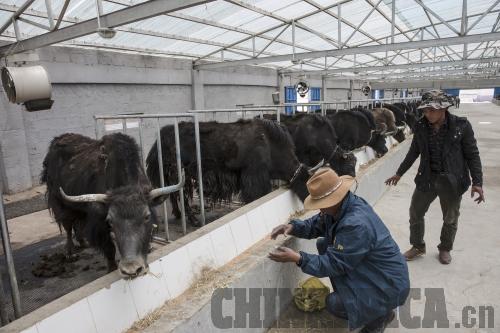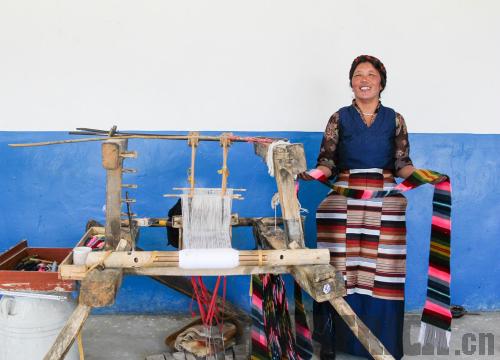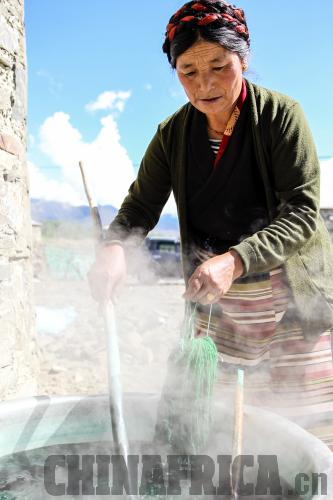| 
Herdsmen attending yaks
The thought of driving 3,300 km for a summer vacation would deter even the most hardened traveler. Add to that, an altitude of over 4,500 meters above sea level makes the trip even more arduous. But that's exactly why Dong Erqiang, his wife and 13-year-old daughter chose not to get away from it all.
Driving along the Qinghai-Tibet Highway from Beijing to the Tibet Autonomous Region on their annual holiday was a great escape for the adventurous family. Along the way, one of the stopovers that caught their eye happened to be a local geothermal pool, where they took time to relax after exhausting days on the road.
"We saw the road sign and decided to try out this special pool. It proved to be worthwhile," Dong told ChinAfrica.
What Dong didn't know was that the pool attraction originally used to be a few geysers off the beaten track two years ago. Local herdsman Karma Samten from Luoma Town, Nagqu Prefecture in north Tibet, was the first to see the potential in the natural resource. His herdsmen's cooperative invested 1.3 million yuan ($206,350) and turned this area into a hot spring resort, which provides employment opportunities for local jobless farmers and herdsmen.
In addition to the pool tourism initiative, the cooperative organized local people to optimize the animal husbandry industry and add value to their agricultural and pastoral products. Now about 130 neighboring families are earning a good income from this industry. Karma Samten's cooperative is a good example of finding creative ways through which Tibetans are improving their livelihoods and increasing their incomes. Tailored to local resources and reality, an increasing number of farmers cooperatives specializing in agriculture, animal husbandry and art and crafts manufacturing have been established. In 2014, there were 2,937 farmers cooperatives in the autonomous region.

Dawa Dolker exhibiting Bangdian aprons
Value-added products
Of the 3.17 million population in Tibet, about 75 percent live in rural areas, supporting themselves mainly through agriculture and pastoral farming. With an average elevation of 4,000 meters, grasslands in the region, which used to support a self-sufficient rural economy, now hardly generate any income.
"Previously, my family raised nearly 500 yaks and sheep. Only a few were sold, bringing an annual income of no more than 10,000 yuan ($1,580)," Karma Samten said. After the founding of the cooperative, his income has been increasing, reaching 80,000 yuan ($12,700) last year, though the number of animals he raised decreased to 200. He attributed this to the value-added products from his animal husbandry related business.
Similar problems also vexed Bunorbu, who lives in an adjacent village.
In the past, the herdsman's family was hard put to find a good use for yak's milk. "Other than processing it into butter to serve the family's table or present to friends and relatives as gifts, yak milk was of no other use. Whenever there was a surplus in milk production, it meant a waste," he said. Bunorbu had thought about processing the milk and selling it in Lhasa, the regional capital city. "But the small amounts turned out by an individual family would yield just low profits which could hardly cover the processing and transportation costs," he said.
In 2006, Bunorbu established the first herdsmen's cooperative in his area, specializing in production and sale of yak milk products like butter and yoghurt. "The cooperative helps all member families with selling channels for their products as well as transportation, thus lowering their operational costs and risks," said Tsring, head of the Agricultural and Pastoral Bureau of Nagqu Prefecture.
"We purchase milk from fellow herdsmen at a higher price and give them dividends after their milk products are sold," said Bunorbu. So far, 1,933 herdsmen from 386 families have participated in the cooperative and benefited. "With yak milk alone, locals annual incomes have increased by 1,500 yuan ($238) on average," said Tsring. By way of cooperatives, the means of production, including grassland, livestock and labor, have been optimized, he said, adding that they enable right people to do right things, thus generating maximum economic results while easing the burden pastoral farming imposes on the local ecology.
Pooling in resources
To join the cooperative, farmers and herdsmen can pool in grassland, livestock, expertise, vehicles and equipment, and share the economic benefits of professional management.
In 2013, Karma Samten founded a construction team in his cooperative. As a good salesman, he has always been successful in finding new projects. Surplus labor and skilled personnel like bricklayers, carpenters and painters in his village are now finding ways to make money outside the busy farming season. The team earned 500,000 yuan ($79,370) last year, enabling 130 rural families to increase their income.
While finding jobs for skilled people, cooperatives provide subsidies for surplus laborers to receive training in new skills tailored to market needs.
In 2007, Menpa from No.28 Village in Nagqu invested 880,000 yuan ($139,680) to establish a sand transportation cooperative. With his financial support, 38 farmers went to vocational schools and now work as excavator and loader operators, welders and electricians.
Kunzang Dorjee, 28, is one of these beneficiaries. He works as an excavator operator on the cooperative and receives a monthly salary of 5,000 yuan ($794). During the past eight years, the sand transportation cooperative has helped raise the living standards of another 685 villagers like him.
Farmers who have seen their lands swallowed up by urbanization have become more creative. In Dongga Village in Lhasa's Doilungdeqen County, farmers were pushed to find opportunities as their lands dwindled. The improved modern transportation network and booming infrastructure development provided them with the opportunity they were looking for. With his experience, reputation and connections accumulated over 10 years, Jampa led his fellow villagers to set up a transportation cooperative. He supported poor families and stood surety for those unable to afford vehicle loans. They can choose to work as drivers in the cooperative businesses. The monthly salary is 3,000 yuan ($476) to 5,000 yuan ($794) based on the transportation distance, Jampa said. To date, the cooperative operates 176 vehicles and 70 percent of farmers in the village have a sustainable source of income.

Local worker dyeing Bangdian
Carrying on the culture
With the concept of specialized cooperatives, pastoral farming culture and traditional handicrafts have not been forgotten.
Tibetan Bangdian is a kind of colorful striped apron made of woolen fabrics. It is worn mostly by married Tibetan women indicating their marital status and also as decorative apparel. In 2006, it was listed as a national intangible cultural heritage.
Tenzin Dolma, 22, is a inheritor of this heritage in Shannan Prefecture. Tenzin Dolma and her mother set up a Bangdian cooperative in 2011 and taught fellow villagers the weaving techniques. Now they have 45 workers, most of whom are housewives from local low-income families.
"It is not a laborious job [and yet] I can earn about 2,000 yuan ($317) every month," Dawa Dolker told ChinAfrica. With seven years experience, she is now a proficient worker who can finish one apron a day.
During the Shanghai World Expo in 2010, Tenzin Dolma attended the Tibetan intangible cultural heritage products exhibition and promoted the traditional handicraft to an international audience. "As it was summer, the woolen apron didn't sell well. But I felt people loved it and there are potential markets for our traditional cultural products," she said.
Now she is learning marketing skills while creating new patterns and styles of the aprons so that they will gain wider popularity, with an aim to lead her fellow villagers to a better life.
The improved livelihood of these Tibetans has gone full circle. Karma Samten's more than substantial income has made it possible for three of his four children to graduate from university. Now his younger daughter is a doctor while her two brothers work as teachers. "My eldest daughter works with me. She will carry on the traditions and culture of my family and our people," he said proudly.
|